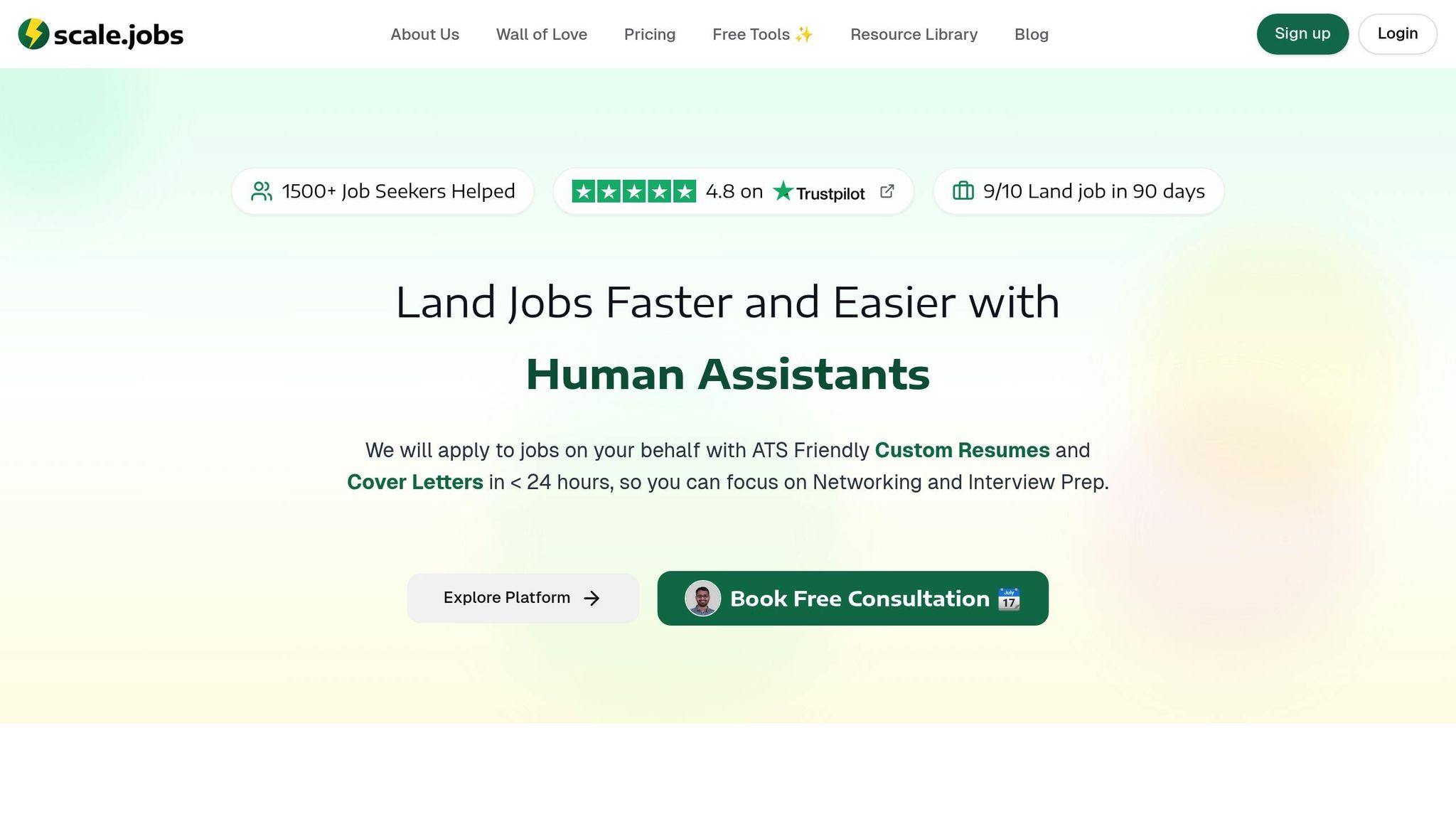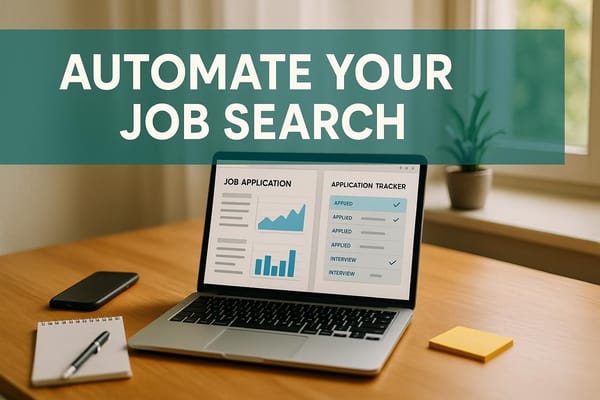Career Roadmap Frameworks for Tech Professionals
Explore effective career roadmap frameworks for tech professionals, guiding skill development and role transitions in a dynamic industry.

Navigating a tech career can be challenging, with constant changes in skills, tools, and roles. A career roadmap framework simplifies this process by offering clear goals, milestones, and strategies for growth. It helps you plan promotions, role transitions, and skill development - whether you're moving up the ladder or switching to a new field. Here's what you need to know:
- Key Elements: Understand job levels, responsibilities, and required skills using competency matrices.
- Role Transitions: Plan vertical moves (e.g., Senior Engineer to Staff Engineer) or lateral shifts (e.g., Developer to Product Manager).
- Skill Stacking: Combine technical and complementary skills to stand out.
- Tools: Platforms like scale.jobs streamline job searches with AI-driven resume optimization and human support, especially for visa-related challenges.
How To Switch To IT Sector From Non IT Background | Non IT To IT Career Roadmap
Core Elements of a Career Roadmap Framework in Tech
A solid tech career roadmap hinges on a few key elements that guide professional development and progression.
Job Levels, Roles, and Responsibilities
Tech career paths often start with clearly defined job hierarchies - from roles like Junior Software Engineer to positions such as Engineering Director. Each comes with its own set of expectations, responsibilities, and compensation levels.
Understanding these distinctions is essential when planning your next step. For instance, while a Software Engineer II might focus on feature development, a Staff Engineer takes on tasks like system design and mentoring team members. Recognizing these differences helps you identify where you stand and where you want to go.
Job search platforms can be incredibly helpful here. By analyzing job descriptions, you can pinpoint the skills and qualifications required for specific roles. This knowledge is invaluable when tailoring your resume and application to match what hiring managers are looking for.
Keep in mind that job titles can vary across companies. Research and tools can help you decode these differences and match equivalent roles and competencies. Once you have clarity on the roles, the next step is aligning your skills with the expectations of your desired position.
Skills and Competency Matrices
After defining roles, a competency matrix becomes a useful tool for mapping out the technical and soft skills needed for growth. Start with core technical skills - programming languages, frameworks, and tools. For example, a machine learning engineer should master Python, TensorFlow, and statistical analysis. Meanwhile, a DevOps engineer might focus on containerization, CI/CD pipelines, and infrastructure automation.
As you move up the ladder, leadership and communication skills gain importance. Senior professionals often find themselves mentoring others, making architectural decisions, and explaining complex technical ideas to non-technical stakeholders. While these abilities may not always be tested in technical interviews, they are critical for advancing in your career.
To stay on track, conduct regular skills gap analyses. Compare your current skill set to the requirements of your target role. This process helps you identify areas for improvement. Additionally, developing complementary skills - such as understanding product management principles - can be a game-changer, especially if you work closely with product teams. Competency matrices are essential for planning both upward and lateral moves in the tech world.
Popular Career Roadmap Frameworks in the Tech Industry
Tech companies rely on structured frameworks to guide career progression, ensuring employees have a clear path for growth. These frameworks are designed to outline advancement opportunities in both technical and managerial roles, focusing on measurable skills and achievements rather than years of experience.
Competency-based models are a cornerstone of these frameworks, encouraging ongoing skill development and setting clear milestones. Many organizations also leverage open-source tools and community-created templates to help employees track their progress and customize their career paths.
These approaches form the foundation for understanding widely-used career roadmap models in the tech industry.
Using Career Roadmaps for Role Transitions
Career roadmaps are a powerful tool when planning role transitions - whether you're aiming for a promotion, switching teams, or stepping into an entirely new position. Think of your roadmap as a dynamic guide that helps you identify skill gaps and chart actionable steps for growth. It’s your blueprint for navigating both upward career moves and lateral shifts.
Vertical and Lateral Career Moves
Vertical moves typically involve climbing the traditional career ladder within your current track. For instance, if a Senior Software Engineer aspires to become a Staff Engineer, they’ll need to hone both technical expertise and leadership skills. A well-thought-out roadmap can pinpoint the exact competencies required and guide you toward projects that challenge and develop these abilities.
On the other hand, lateral moves are excellent for broadening your skill set and expanding your professional network. For example, shifting from one technical domain to another or transitioning from an individual contributor role to a management position can open doors to new opportunities. A career roadmap helps you assess which of your current skills are transferable and what new ones you’ll need to succeed in a different role.
If you’re moving from an individual contributor role to management, leadership skills become crucial. Demonstrating abilities like mentoring, coordinating projects, and collaborating across teams is essential. A detailed roadmap can help you focus on areas for growth and identify opportunities for formal training or job shadowing to ease the transition.
Skill Stacking and Cross-Functional Expertise
Skill stacking is about combining complementary skills to create a unique edge in your career. For example, a data scientist who also understands product strategy or a software engineer who learns UX design can offer more well-rounded solutions. These combinations make you stand out and increase your value in the workplace.
To approach skill stacking strategically, use your roadmap to identify which additional skills will amplify your core strengths. For instance, you might explore areas like system architecture, data engineering, or technical product management - whichever aligns best with your goals.
Cross-functional expertise often comes from working on collaborative projects or participating in role rotations. Many tech companies encourage internal mobility, allowing employees to work with different teams and gain insight into various workflows. These experiences not only broaden your skill set but also improve your ability to communicate across departments and tackle complex business challenges. Such cross-functional growth naturally feeds into effective career planning.
Practical Framework Application
To put your career roadmap into action, start with a self-assessment. Compare your current skills to the requirements of your target role. Many career frameworks provide rubrics that can help you pinpoint specific areas for improvement.
Next, create a skills inventory that maps your existing abilities to the framework’s expectations. Use a simple rating system to visualize where you excel and where you need to grow. Regularly updating this inventory will help you track progress over time.
With this assessment in hand, set clear, measurable goals. Instead of vague objectives, focus on actionable steps - like improving mentorship skills by guiding junior engineers through challenging projects. Breaking larger transitions into smaller milestones can make progress feel more manageable and keep you motivated.
Mentorship can also play a big role in your career transition. A mentor who has successfully navigated a similar path can offer guidance, feedback, and help you spot new opportunities. Regular check-ins with a mentor can be invaluable.
Finally, document your progress consistently. Take on stretch assignments, propose creative projects, or contribute your expertise to different teams. These efforts not only build your skills but also demonstrate your readiness for the next step in your career journey.
Best Tools and Platforms for Career Roadmap Design and Job Transitions
Once you've mapped out your career transition, it's time to pick the right tools to bring your plan to life. Today’s job search landscape is packed with platforms offering everything from AI-driven resume tweaking to hands-on application support. For tech professionals, especially those navigating visa hurdles or stiff competition, finding the right tools is key.
scale.jobs: A One-Stop Job Search Platform

scale.jobs is a standout option for tech professionals looking to simplify their job search. Unlike traditional job boards that only focus on one part of the process, scale.jobs combines software, AI tools, and human-powered services into a single platform.
The free version includes a job tracker, an ATS-friendly resume builder, and access to over 2 million job postings. Tech professionals can also generate two AI-customized resumes and one AI-crafted cover letter daily, along with AI support for application questions and interview prep - all at no cost.
For those managing a more intense job search, the AI Assistant Pro plan offers unlimited AI-generated outputs at an introductory promotional rate. This is especially handy for professionals applying to multiple roles, as it provides tailored materials for each position.
The platform also offers a Human Assistant service with a 24-hour turnaround. This includes real-time WhatsApp updates and proof-of-work screenshots, making it an excellent option for immigrant tech workers dealing with complex visa documentation.
Other perks include compatibility with a variety of job portals - from major corporate ATS systems to niche boards - and a flat-fee pricing model that eliminates recurring costs. With flexible packages to match different application needs, scale.jobs brings together all the tools and services you need in one place.
How scale.jobs Stacks Up Against Competitors
scale.jobs’ integrated approach sets it apart in a crowded market. Here’s how it compares to other platforms:
- Find My Profession: While this platform focuses on resume writing and LinkedIn optimization, it lacks ongoing application support and real-time communication features like scale.jobs’ WhatsApp updates and proof-of-work documentation.
- LazyApply: This service automates application submissions, which can save time but risks ATS systems flagging or rejecting applications. scale.jobs avoids this issue by using human oversight to ensure each application is customized and compliant.
- Simplify.jobs: This browser-based tool simplifies the application process but doesn’t offer personalized resume tailoring or human support. Users are left to handle customization on their own, which can be a challenge for tech professionals aiming for highly specific roles.
What makes scale.jobs stand out?
- Human verification to avoid bot detection issues.
- Flat-fee pricing with no hidden subscription costs.
- A mix of advanced tools and hands-on application support.
- Tailored help for visa-related challenges faced by immigrant tech professionals.
- Real-time updates and documented proof of work for accountability.
Other Tools to Enhance Career Mapping
While scale.jobs provides an all-in-one solution, there are other tools that can complement your career strategy. For example:
- Jobscan.co: This tool specializes in ATS optimization, helping you align your resume with job descriptions by offering detailed keyword suggestions.
- Rezi.ai: Known for its AI-powered resume builder, Rezi.ai also provides real-time ATS scoring to ensure your resume is ready to make it past automated systems.
Though these tools are great for specific tasks like resume building or keyword optimization, they don’t offer the comprehensive application management and human assistance that scale.jobs delivers.
Ultimately, your choice depends on what you value most - whether it’s managing every detail yourself or freeing up time to focus on networking and interview prep by leveraging a platform like scale.jobs.
Conclusion and Key Takeaways
Career roadmap frameworks are a powerful tool for driving meaningful career progress. Whether you're stepping into your first job as a recent graduate or transitioning from an engineering role into management, having a clear, structured plan can make a huge difference.
These frameworks break down career growth into well-defined roles, specific skills, and achievable milestones. By doing so, they eliminate the uncertainty of career planning and provide clear, actionable steps to follow.
For tech professionals navigating career transitions, it’s important to recognize that growth isn’t always a straight climb upward. Sometimes, lateral moves can be just as valuable as promotions, especially when they help you build cross-functional expertise. The concept of skill stacking - pairing technical expertise with complementary skills - becomes increasingly critical as the tech landscape continues to evolve.
To start, take an honest look at your current skills and compare them to the requirements of your target role. Identify the gaps and create a timeline for bridging them with actionable steps. This could mean earning certifications, contributing to open-source projects, or gaining hands-on experience with new tools and technologies.
Leveraging the right tools can also make a big difference. For example, platforms like scale.jobs simplify job searches by addressing common challenges like bot-detection systems and visa issues. Their AI-human hybrid model and human assistant services free up time, allowing you to focus on high-value activities like networking and skill-building. For tech professionals balancing a full-time job with a job search, this kind of support can be a game-changer.
Finally, remember that career roadmaps aren’t set in stone. The tech industry evolves rapidly, with new roles and skills emerging all the time. Regularly updating your roadmap ensures it stays aligned with both industry trends and your personal growth. While the framework provides structure, staying adaptable is what will keep you ahead in this fast-moving field. Flexibility combined with a clear plan is the key to staying competitive in tech.
FAQs
How can a competency matrix help me identify skill gaps and plan my career growth in tech?
A competency matrix is a practical tool for tech professionals to evaluate their skills and uncover areas that need attention. By laying out the skills required for your target role and comparing them to your current abilities, you can clearly identify gaps and build a focused plan to bridge them.
This approach helps you set specific, achievable goals while ensuring your career growth stays aligned with industry expectations. For instance, if you're shifting to a new tech role, a competency matrix can help you prioritize what matters most - whether that's earning certifications, sharpening technical skills, or refining soft skills. Platforms like scale.jobs can be a useful ally, offering resources such as ATS-friendly resumes, networking tools, and AI-driven job search features to support your career journey.
What’s the difference between vertical and lateral career moves, and how can a career roadmap help with these transitions?
Vertical career moves typically mean stepping into roles with more responsibility, better pay, or a higher-ranking title. On the other hand, lateral moves involve shifting to a position at a similar level but in a different area or department, often to expand your skill set or explore different interests.
Having a career roadmap can make these transitions much smoother. It gives you a clear structure by laying out your long-term goals, pinpointing any skill gaps, and breaking down actionable steps to reach your objectives. For tech professionals, using industry-specific frameworks can be especially helpful. They allow you to strategically prepare for promotions or shift into new roles, keeping you competitive in the ever-changing job market.
How can combining technical and complementary skills improve my career, and what are some practical ways to develop them?
Skill stacking - blending technical know-how with complementary abilities - can give your career a serious boost by making you more adaptable and competitive in today’s job market. Imagine combining programming expertise with strong communication or project management skills. This mix can position you for leadership roles or make you an asset in cross-functional teams.
To create a powerful skill stack, start by pinpointing the skills that align with your career ambitions. For tech professionals, this might mean pairing coding with data analysis, cloud computing, or UX design. Don’t overlook the importance of soft skills like problem-solving, time management, and teamwork - they’re often the glue that holds everything together. The key is to embrace continuous learning through online courses, workshops, and hands-on experience to build a skill set that stands out.




